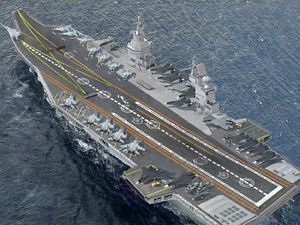The Russian Navy has commenced research on engine designs for Russia’s planned nuclear-powered supercarrier, dubbed Project 23000E Shtorm (Storm), the chief of the Russian Navy’s shipbuilding department, Rear Admiral Vladimir Tryapichnikov, said in a television interview on August 24.
“Today, an engine has been launched [the research work on its creation has been launched] and today we are working precisely on this issue,” Tryapichnikov said on Zvezda TV Channel last Friday. “Some concept will be approved in the near future. Of course, this is expensive but such a ship should be built.”
The principal design work for the new carrier is being undertaken by the St. Petersburg-based Nevskoye Planning and Design bureau, Russia’s primary designer of large surface warships. Tryapichnikov’s comments once more raise the question whether a Russian nuclear-powered aircraft carrier project will ever move beyond the design stage and whether the Russian Navy has a need for a flattop.
“This is a very complex issue,” Tryapichnikov said in response to a question whether the Navy has a requirement for a carrier. “It is, indeed, being worked out today by the design bureaus of the United Shipbuilding Corporation. It is also being decided by shipyards as capacities are needed to create such a warship.” (Russia’s shipbuilding industry lacks a large enough dry dock to accommodate a warship the size of a supercarrier.)
As I reported previously, a supercarrier would take up to 10 years to build and cost as much as $9 billion excluding operational costs. A design for a Russian supercarrier was first revealed in May 2015 by the Krylovsky State Research Center (KRSC), a Russian shipbuilding research and development institute. Based on information supplied by KRSC, the flattop would displace 90,000-100,000 tons, will be 330 meters long, 40 meters wide, and will have a draft of 11 meters. The ship would be able to carry 80-90 deck-based aircraft.
The supercarrier, fitted with a Catapult Assisted Take-Off But Arrested Recovery (CATOBAR) aircraft launch system, could be inducted into service by 2030, according to Russian defense industry sources.
Chances that the program will move beyond the design stage remain slim. First, Russia has never built a nuclear-powered aircraft carrier and lacks expertise. All Soviet carriers were constructed in Ukraine. Second, given current budgetary realities, it appears unlikely that the Russian Ministry of Defense will allocate billions of dollars to a project that only vicariously supports the core mission of the Russian Navy — nuclear deterrence. Third, even if Russia were to eventually float out a carrier, it would still lack crucial other assets to successfully field a carrier strike group including carrier-capable next-generation fighter, tactical airborne early warning, and electronic warfare aircraft, as well as support vessels.






























